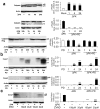The HSV-2 mutant DeltaPK induces melanoma oncolysis through nonredundant death programs and associated with autophagy and pyroptosis proteins
- PMID: 19798049
- PMCID: PMC2904070
- DOI: 10.1038/gt.2009.126
The HSV-2 mutant DeltaPK induces melanoma oncolysis through nonredundant death programs and associated with autophagy and pyroptosis proteins
Abstract
Malignant melanoma is a highly aggressive and drug-resistant cancer. Virotherapy is a novel therapeutic strategy based on cancer cell lysis through selective virus replication. However, its clinical efficacy is modest, apparently related to poor virus replication within the tumors. We report that the growth compromised herpes simplex virus type 2 (HSV-2) mutant, DeltaPK, has strong oncolytic activity for melanoma largely caused by a mechanism other than replication-induced cell lysis. The ratio of dead cells (determined by trypan blue or ethidium homodimer staining) to cells that stain with antibody to the major capsid protein VP5 (indicative of productive infection) was 1.8-4.1 for different melanoma cultures at 24-72 h post-infection. Cell death was due to activation of calpain as well as caspases-7 and -3 and it was abolished by the combination of calpain (PD150606) and pancaspase (benzyloxycarbonyl-Val-Ala-Asp-fluormethyl ketone, z-VAD-fmk) inhibitors. Upregulation of the autopahgy protein Beclin-1 and the pro-apoptotic protein H11/HspB8 accompanied DeltaPK-induced melanoma oncolysis. Intratumoral DeltaPK injection (10(6)-10(7) plaque-forming unit (pfu)) significantly reduced melanoma tumor burden associated with calpain and caspases-7 and -3 activation, Beclin-1 and H11/HspB8 upregulation and activation of caspase-1-related inflammation. Complete remission was seen for 87.5% of the LM melanoma xenografts at 5 months after treatment termination. The data indicate that DeltaPK is a promising virotherapy for melanoma that functions through virus-induced programmed cell death pathways.
Figures








Similar articles
-
Calpain-dependent clearance of the autophagy protein p62/SQSTM1 is a contributor to ΔPK oncolytic activity in melanoma.Gene Ther. 2014 Apr;21(4):371-8. doi: 10.1038/gt.2014.6. Epub 2014 Feb 20. Gene Ther. 2014. PMID: 24553345 Free PMC article.
-
ΔPK oncolytic activity includes modulation of the tumour cell milieu.J Gen Virol. 2016 Feb;97(2):496-508. doi: 10.1099/jgv.0.000353. Epub 2015 Nov 24. J Gen Virol. 2016. PMID: 26602205 Free PMC article.
-
A mutant type 2 herpes simplex virus deleted for the protein kinase domain of the ICP10 gene is a potent oncolytic virus.Mol Ther. 2006 May;13(5):882-90. doi: 10.1016/j.ymthe.2006.02.007. Epub 2006 Mar 29. Mol Ther. 2006. PMID: 16569513
-
The oncolytic virus ΔPK has multimodal anti-tumor activity.Pathog Dis. 2016 Jul;74(5):ftw050. doi: 10.1093/femspd/ftw050. Epub 2016 May 29. Pathog Dis. 2016. PMID: 27242376 Free PMC article. Review.
-
Talimogene Laherparepvec (T-VEC) and Other Oncolytic Viruses for the Treatment of Melanoma.Am J Clin Dermatol. 2017 Feb;18(1):1-15. doi: 10.1007/s40257-016-0238-9. Am J Clin Dermatol. 2017. PMID: 27988837 Free PMC article. Review.
Cited by
-
Non-Apoptotic Cell Death Signaling Pathways in Melanoma.Int J Mol Sci. 2020 Apr 23;21(8):2980. doi: 10.3390/ijms21082980. Int J Mol Sci. 2020. PMID: 32340261 Free PMC article. Review.
-
Oncolytic viruses as therapeutic cancer vaccines.Mol Cancer. 2013 Sep 11;12(1):103. doi: 10.1186/1476-4598-12-103. Mol Cancer. 2013. PMID: 24020520 Free PMC article. Review.
-
Oncolytic Virus-Induced Autophagy in Glioblastoma.Cancers (Basel). 2021 Jul 12;13(14):3482. doi: 10.3390/cancers13143482. Cancers (Basel). 2021. PMID: 34298694 Free PMC article. Review.
-
Newcastle-disease-virus-induced ferroptosis through nutrient deprivation and ferritinophagy in tumor cells.iScience. 2021 Jul 10;24(8):102837. doi: 10.1016/j.isci.2021.102837. eCollection 2021 Aug 20. iScience. 2021. PMID: 34368653 Free PMC article.
-
Neutrophil Extracellular Traps and Their Possible Implications in Ocular Herpes Infection.Pathogens. 2023 Jan 29;12(2):209. doi: 10.3390/pathogens12020209. Pathogens. 2023. PMID: 36839481 Free PMC article. Review.
References
-
- Jemal A, Siegel R, Ward E, Murray T, Xu J, Thun MJ. Cancer statistics, 2007. CA Cancer J Clin. 2007;57:43–66. - PubMed
-
- Shen Y, Nemunaitis J. Herpes simplex virus 1 (HSV-1) for cancer treatment. Cancer Gene Ther. 2006;13:975–992. - PubMed
-
- Mathis JM, Stoff-Khalili MA, Curiel DT. Oncolytic adenoviruses - selective retargeting to tumor cells. Oncogene. 2005;24:7775–7791. - PubMed
-
- Ribacka C, Pesonen S, Hemminki A. Cancer, stem cells, and oncolytic viruses. Ann Med. 2008;40:496–505. - PubMed
Publication types
MeSH terms
Substances
Grants and funding
LinkOut - more resources
Full Text Sources
Other Literature Sources
Medical

